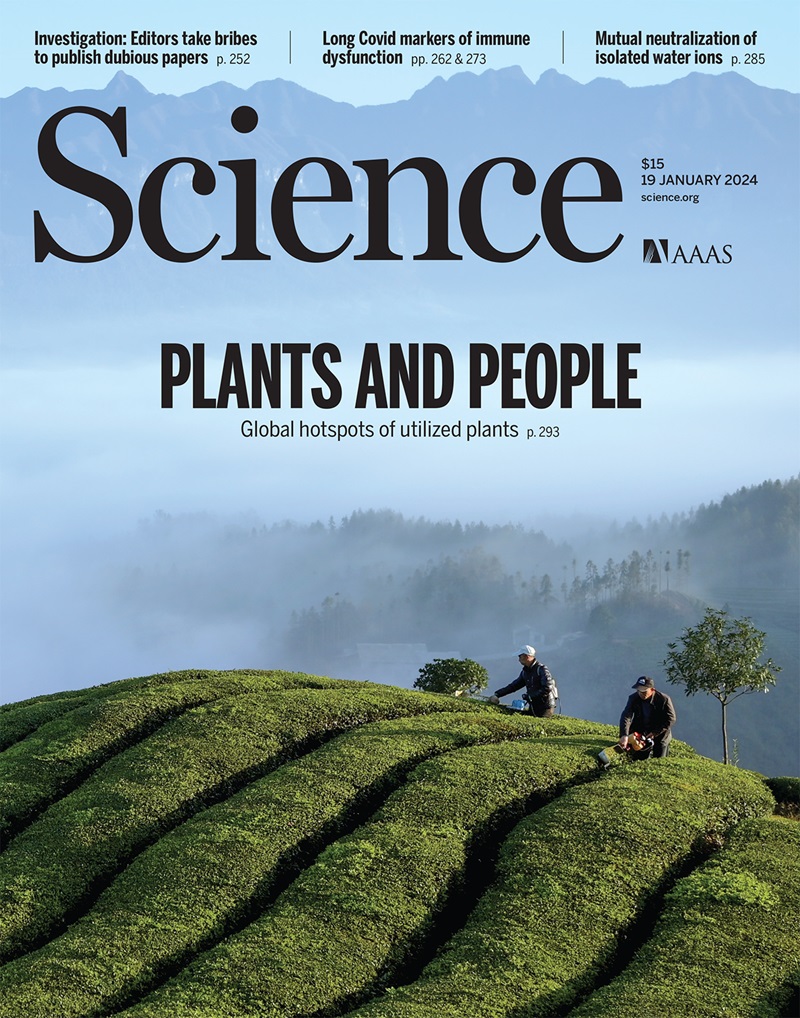The helion charge radius from laser spectroscopy of muonic helium-3 ions
IF 44.7
1区 综合性期刊
Q1 MULTIDISCIPLINARY SCIENCES
引用次数: 0
Abstract
Hydrogen-like light muonic ions, in which one negative muon replaces all of the electrons, are extremely sensitive probes of nuclear structure. Using pulsed laser spectroscopy, we have measured three 2S-2P transitions in the muonic helium-3 (μ3He+) ion, an ion formed by a negative muon and bare helium-3 nucleus. This allowed us to extract the Lamb shift, the 2P fine structure splitting, and the 2S-hyperfine splitting in μ3He+. Comparing these measurements with theory, we determined the root-mean-square charge radius of the helion (3He nucleus) to be rh = 1.97007(94) fm, in good agreement with the value from elastic electron scattering but a factor 15 more accurate. Our results represent benchmarks for few-nucleon theories and open the way for precision quantum electrodynamics tests in He atoms and ions.
氦-3介子离子的激光光谱学研究
类氢光介子离子,其中一个负的介子取代了所有的电子,是对核结构极其敏感的探针。利用脉冲激光光谱,我们测量了介子氦-3 (μ3He+)离子中的三个2S-2P跃迁,这是一个由负介子和裸氦-3核形成的离子。这使我们能够在μ3He+中提取Lamb位移、2P精细结构分裂和2s超精细分裂。将这些测量值与理论值进行比较,我们确定了荷子(3He核)的均方根电荷半径为rh = 1.97007(94) fm,与弹性电子散射的值很好地吻合,但比理论值精确15倍。我们的结果代表了少核子理论的基准,并为He原子和离子的精确量子电动力学测试开辟了道路。
本文章由计算机程序翻译,如有差异,请以英文原文为准。
求助全文
约1分钟内获得全文
求助全文
来源期刊

Science
综合性期刊-综合性期刊
CiteScore
61.10
自引率
0.90%
发文量
0
审稿时长
2.1 months
期刊介绍:
Science is a leading outlet for scientific news, commentary, and cutting-edge research. Through its print and online incarnations, Science reaches an estimated worldwide readership of more than one million. Science’s authorship is global too, and its articles consistently rank among the world's most cited research.
Science serves as a forum for discussion of important issues related to the advancement of science by publishing material on which a consensus has been reached as well as including the presentation of minority or conflicting points of view. Accordingly, all articles published in Science—including editorials, news and comment, and book reviews—are signed and reflect the individual views of the authors and not official points of view adopted by AAAS or the institutions with which the authors are affiliated.
Science seeks to publish those papers that are most influential in their fields or across fields and that will significantly advance scientific understanding. Selected papers should present novel and broadly important data, syntheses, or concepts. They should merit recognition by the wider scientific community and general public provided by publication in Science, beyond that provided by specialty journals. Science welcomes submissions from all fields of science and from any source. The editors are committed to the prompt evaluation and publication of submitted papers while upholding high standards that support reproducibility of published research. Science is published weekly; selected papers are published online ahead of print.
 求助内容:
求助内容: 应助结果提醒方式:
应助结果提醒方式:


